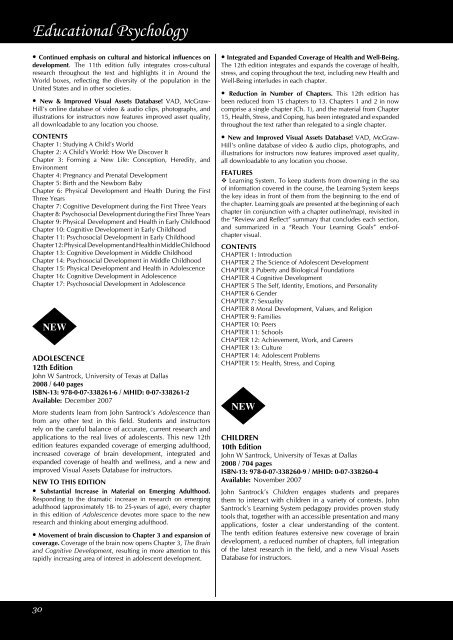table of contents - McGraw-Hill Books
table of contents - McGraw-Hill Books
table of contents - McGraw-Hill Books
You also want an ePaper? Increase the reach of your titles
YUMPU automatically turns print PDFs into web optimized ePapers that Google loves.
Educational Psychology<br />
• Continued emphasis on cultural and historical influences on<br />
development. The 11th edition fully integrates cross-cultural<br />
research throughout the text and highlights it in Around the<br />
World boxes, reflecting the diversity <strong>of</strong> the population in the<br />
United States and in other societies.<br />
• New & Improved Visual Assets Database! VAD, <strong>McGraw</strong>-<br />
<strong>Hill</strong>’s online database <strong>of</strong> video & audio clips, photographs, and<br />
illustrations for instructors now features improved asset quality,<br />
all downloadable to any location you choose.<br />
CONTENTS<br />
Chapter 1: Studying A Child’s World<br />
Chapter 2: A Child’s World: How We Discover It<br />
Chapter 3: Forming a New Life: Conception, Heredity, and<br />
Environment<br />
Chapter 4: Pregnancy and Prenatal Development<br />
Chapter 5: Birth and the Newborn Baby<br />
Chapter 6: Physical Development and Health During the First<br />
Three Years<br />
Chapter 7: Cognitive Development during the First Three Years<br />
Chapter 8: Psychosocial Development during the First Three Years<br />
Chapter 9: Physical Development and Health in Early Childhood<br />
Chapter 10: Cognitive Development in Early Childhood<br />
Chapter 11: Psychosocial Development in Early Childhood<br />
Chapter 12: Physical Development and Health in Middle Childhood<br />
Chapter 13: Cognitive Development in Middle Childhood<br />
Chapter 14: Psychosocial Development in Middle Childhood<br />
Chapter 15: Physical Development and Health in Adolescence<br />
Chapter 16: Cognitive Development in Adolescence<br />
Chapter 17: Psychosocial Development in Adolescence<br />
NEW<br />
ADOLESCENCE<br />
12th Edition<br />
John W Santrock, University <strong>of</strong> Texas at Dallas<br />
2008 / 640 pages<br />
ISBN-13: 978-0-07-338261-6 / MHID: 0-07-338261-2<br />
Available: December 2007<br />
More students learn from John Santrock’s Adolescence than<br />
from any other text in this field. Students and instructors<br />
rely on the careful balance <strong>of</strong> accurate, current research and<br />
applications to the real lives <strong>of</strong> adolescents. This new 12th<br />
edition features expanded coverage <strong>of</strong> emerging adulthood,<br />
increased coverage <strong>of</strong> brain development, integrated and<br />
expanded coverage <strong>of</strong> health and wellness, and a new and<br />
improved Visual Assets Database for instructors.<br />
NEW TO THIS EDITION<br />
• Substantial Increase in Material on Emerging Adulthood.<br />
Responding to the dramatic increase in research on emerging<br />
adulthood (approximately 18- to 25-years <strong>of</strong> age), every chapter<br />
in this edition <strong>of</strong> Adolescence devotes more space to the new<br />
research and thinking about emerging adulthood.<br />
• Movement <strong>of</strong> brain discussion to Chapter 3 and expansion <strong>of</strong><br />
coverage. Coverage <strong>of</strong> the brain now opens Chapter 3, The Brain<br />
and Cognitive Development, resulting in more attention to this<br />
rapidly increasing area <strong>of</strong> interest in adolescent development.<br />
• Integrated and Expanded Coverage <strong>of</strong> Health and Well-Being.<br />
The 12th edition integrates and expands the coverage <strong>of</strong> health,<br />
stress, and coping throughout the text, including new Health and<br />
Well-Being interludes in each chapter.<br />
• Reduction in Number <strong>of</strong> Chapters. This 12th edition has<br />
been reduced from 15 chapters to 13. Chapters 1 and 2 in now<br />
comprise a single chapter (Ch. 1), and the material from Chapter<br />
15, Health, Stress, and Coping, has been integrated and expanded<br />
throughout the text rather than relegated to a single chapter.<br />
• New and Improved Visual Assets Database! VAD, <strong>McGraw</strong>-<br />
<strong>Hill</strong>’s online database <strong>of</strong> video & audio clips, photographs, and<br />
illustrations for instructors now features improved asset quality,<br />
all downloadable to any location you choose.<br />
FEATURES<br />
v Learning System. To keep students from drowning in the sea<br />
<strong>of</strong> information covered in the course, the Learning System keeps<br />
the key ideas in front <strong>of</strong> them from the beginning to the end <strong>of</strong><br />
the chapter. Learning goals are presented at the beginning <strong>of</strong> each<br />
chapter (in conjunction with a chapter outline/map), revisited in<br />
the “Review and Reflect” summary that concludes each section,<br />
and summarized in a “Reach Your Learning Goals” end-<strong>of</strong>chapter<br />
visual.<br />
CONTENTS<br />
CHAPTER 1: Introduction<br />
CHAPTER 2 The Science <strong>of</strong> Adolescent Development<br />
CHAPTER 3 Puberty and Biological Foundations<br />
CHAPTER 4 Cognitive Development<br />
CHAPTER 5 The Self, Identity, Emotions, and Personality<br />
CHAPTER 6 Gender<br />
CHAPTER 7: Sexuality<br />
CHAPTER 8 Moral Development, Values, and Religion<br />
CHAPTER 9: Families<br />
CHAPTER 10: Peers<br />
CHAPTER 11: Schools<br />
CHAPTER 12: Achievement, Work, and Careers<br />
CHAPTER 13: Culture<br />
CHAPTER 14: Adolescent Problems<br />
CHAPTER 15: Health, Stress, and Coping<br />
NEW<br />
CHILDREN<br />
10th Edition<br />
John W Santrock, University <strong>of</strong> Texas at Dallas<br />
2008 / 704 pages<br />
ISBN-13: 978-0-07-338260-9 / MHID: 0-07-338260-4<br />
Available: November 2007<br />
John Santrock’s Children engages students and prepares<br />
them to interact with children in a variety <strong>of</strong> contexts. John<br />
Santrock’s Learning System pedagogy provides proven study<br />
tools that, together with an accessible presentation and many<br />
applications, foster a clear understanding <strong>of</strong> the content.<br />
The tenth edition features extensive new coverage <strong>of</strong> brain<br />
development, a reduced number <strong>of</strong> chapters, full integration<br />
<strong>of</strong> the latest research in the field, and a new Visual Assets<br />
Database for instructors.<br />
30

















